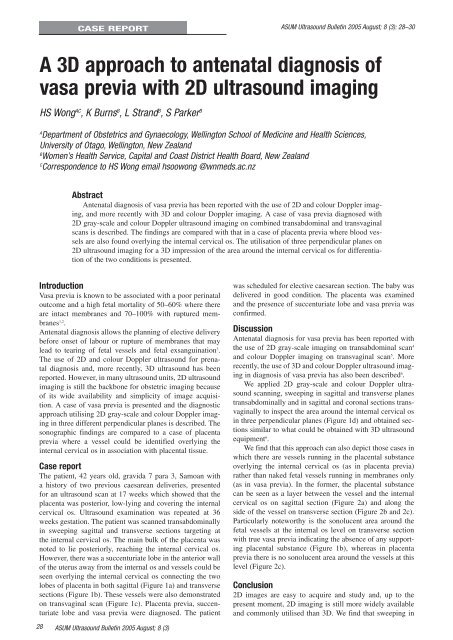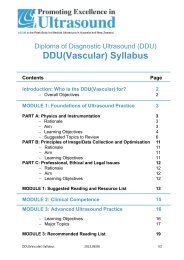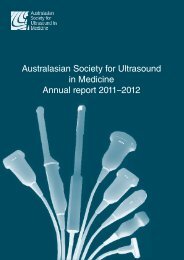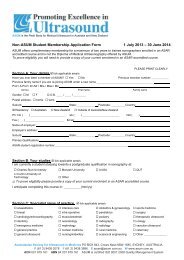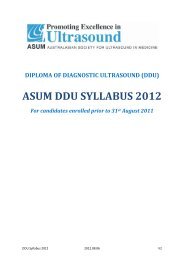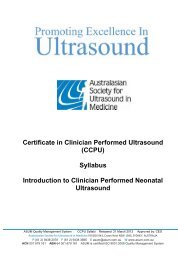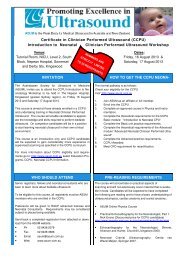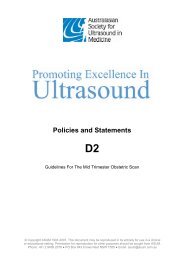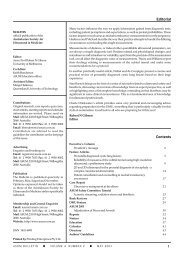Volume 8 Issue 3 - Australasian Society for Ultrasound in Medicine
Volume 8 Issue 3 - Australasian Society for Ultrasound in Medicine
Volume 8 Issue 3 - Australasian Society for Ultrasound in Medicine
You also want an ePaper? Increase the reach of your titles
YUMPU automatically turns print PDFs into web optimized ePapers that Google loves.
CASE REPORTASUM <strong>Ultrasound</strong> Bullet<strong>in</strong> 2005 August; 8 (3): 28–30A 3D approach to antenatal diagnosis ofvasa previa with 2D ultrasound imag<strong>in</strong>gHS Wong AC , K Burns B , L Strand B , S Parker BADepartment of Obstetrics and Gynaecology, Well<strong>in</strong>gton School of Medic<strong>in</strong>e and Health Sciences,University of Otago, Well<strong>in</strong>gton, New ZealandBWomen’s Health Service, Capital and Coast District Health Board, New ZealandCCorrespondence to HS Wong email hsoowong @wnmeds.ac.nzAbstractAntenatal diagnosis of vasa previa has been reported with the use of 2D and colour Doppler imag<strong>in</strong>g,and more recently with 3D and colour Doppler imag<strong>in</strong>g. A case of vasa previa diagnosed with2D gray-scale and colour Doppler ultrasound imag<strong>in</strong>g on comb<strong>in</strong>ed transabdom<strong>in</strong>al and transvag<strong>in</strong>alscans is described. The f<strong>in</strong>d<strong>in</strong>gs are compared with that <strong>in</strong> a case of placenta previa where blood vesselsare also found overly<strong>in</strong>g the <strong>in</strong>ternal cervical os. The utilisation of three perpendicular planes on2D ultrasound imag<strong>in</strong>g <strong>for</strong> a 3D impression of the area around the <strong>in</strong>ternal cervical os <strong>for</strong> differentiationof the two conditions is presented.IntroductionVasa previa is known to be associated with a poor per<strong>in</strong>ataloutcome and a high fetal mortality of 50–60% where thereare <strong>in</strong>tact membranes and 70–100% with ruptured membranes1,2 .Antenatal diagnosis allows the plann<strong>in</strong>g of elective deliverybe<strong>for</strong>e onset of labour or rupture of membranes that maylead to tear<strong>in</strong>g of fetal vessels and fetal exsangu<strong>in</strong>ation 3 .The use of 2D and colour Doppler ultrasound <strong>for</strong> prenataldiagnosis and, more recently, 3D ultrasound has beenreported. However, <strong>in</strong> many ultrasound units, 2D ultrasoundimag<strong>in</strong>g is still the backbone <strong>for</strong> obstetric imag<strong>in</strong>g becauseof its wide availability and simplicity of image acquisition.A case of vasa previa is presented and the diagnosticapproach utilis<strong>in</strong>g 2D gray-scale and colour Doppler imag<strong>in</strong>g<strong>in</strong> three different perpendicular planes is described. Thesonographic f<strong>in</strong>d<strong>in</strong>gs are compared to a case of placentaprevia where a vessel could be identified overly<strong>in</strong>g the<strong>in</strong>ternal cervical os <strong>in</strong> association with placental tissue.Case reportThe patient, 42 years old, gravida 7 para 3, Samoan witha history of two previous caesarean deliveries, presented<strong>for</strong> an ultrasound scan at 17 weeks which showed that theplacenta was posterior, low-ly<strong>in</strong>g and cover<strong>in</strong>g the <strong>in</strong>ternalcervical os. <strong>Ultrasound</strong> exam<strong>in</strong>ation was repeated at 36weeks gestation. The patient was scanned transabdom<strong>in</strong>ally<strong>in</strong> sweep<strong>in</strong>g sagittal and transverse sections target<strong>in</strong>g atthe <strong>in</strong>ternal cervical os. The ma<strong>in</strong> bulk of the placenta wasnoted to lie posteriorly, reach<strong>in</strong>g the <strong>in</strong>ternal cervical os.However, there was a succenturiate lobe <strong>in</strong> the anterior wallof the uterus away from the <strong>in</strong>ternal os and vessels could beseen overly<strong>in</strong>g the <strong>in</strong>ternal cervical os connect<strong>in</strong>g the twolobes of placenta <strong>in</strong> both sagittal (Figure 1a) and transversesections (Figure 1b). These vessels were also demonstratedon transvag<strong>in</strong>al scan (Figure 1c). Placenta previa, succenturiatelobe and vasa previa were diagnosed. The patientwas scheduled <strong>for</strong> elective caesarean section. The baby wasdelivered <strong>in</strong> good condition. The placenta was exam<strong>in</strong>edand the presence of succenturiate lobe and vasa previa wasconfirmed.DiscussionAntenatal diagnosis <strong>for</strong> vasa previa has been reported withthe use of 2D gray-scale imag<strong>in</strong>g on transabdom<strong>in</strong>al scan 4and colour Doppler imag<strong>in</strong>g on transvag<strong>in</strong>al scan 5 . Morerecently, the use of 3D and colour Doppler ultrasound imag<strong>in</strong>g<strong>in</strong> diagnosis of vasa previa has also been described 6 .We applied 2D gray-scale and colour Doppler ultrasoundscann<strong>in</strong>g, sweep<strong>in</strong>g <strong>in</strong> sagittal and transverse planestransabdom<strong>in</strong>ally and <strong>in</strong> sagittal and coronal sections transvag<strong>in</strong>allyto <strong>in</strong>spect the area around the <strong>in</strong>ternal cervical os<strong>in</strong> three perpendicular planes (Figure 1d) and obta<strong>in</strong>ed sectionssimilar to what could be obta<strong>in</strong>ed with 3D ultrasoundequipment 6 .We f<strong>in</strong>d that this approach can also depict those cases <strong>in</strong>which there are vessels runn<strong>in</strong>g <strong>in</strong> the placental substanceoverly<strong>in</strong>g the <strong>in</strong>ternal cervical os (as <strong>in</strong> placenta previa)rather than naked fetal vessels runn<strong>in</strong>g <strong>in</strong> membranes only(as <strong>in</strong> vasa previa). In the <strong>for</strong>mer, the placental substancecan be seen as a layer between the vessel and the <strong>in</strong>ternalcervical os on sagittal section (Figure 2a) and along theside of the vessel on transverse section (Figure 2b and 2c).Particularly noteworthy is the sonolucent area around thefetal vessels at the <strong>in</strong>ternal os level on transverse sectionwith true vasa previa <strong>in</strong>dicat<strong>in</strong>g the absence of any support<strong>in</strong>gplacental substance (Figure 1b), whereas <strong>in</strong> placentaprevia there is no sonolucent area around the vessels at thislevel (Figure 2c).Conclusion2D images are easy to acquire and study and, up to thepresent moment, 2D imag<strong>in</strong>g is still more widely availableand commonly utilised than 3D. We f<strong>in</strong>d that sweep<strong>in</strong>g <strong>in</strong>28 ASUM <strong>Ultrasound</strong> Bullet<strong>in</strong> 2005 August; 8 (3)


